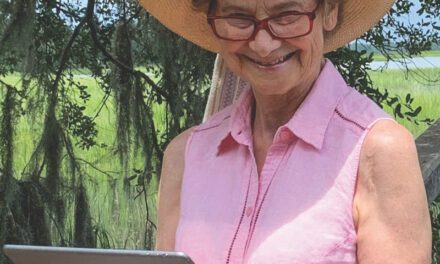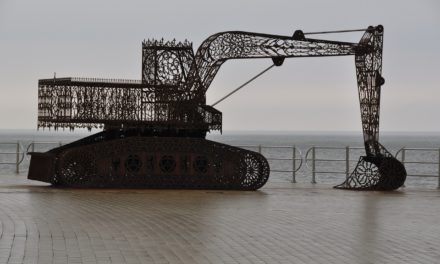 This is the first in a series about Roger Pinckney XI, his life
This is the first in a series about Roger Pinckney XI, his life on Daufuskie Island, and his book, Reefer Moon. Readers are encouraged to purchase Reefer Moon and participate in the Lowcountry’s first virtual book club on Facebook.
on Daufuskie Island, and his book, Reefer Moon. Readers are encouraged to purchase Reefer Moon and participate in the Lowcountry’s first virtual book club on Facebook.
Several years ago in 2005, I had the pleasure of meeting Roger Pinckney XI. The Beaufort Book Store hosted the two of us for a book signing. I was signing copies of my book, Port Royal; and Roger was embossing his signature on his debut collection of essays, The Right Side of the River.
I was intrigued from the moment I met Roger. He was truthful, funny and real. And his love for Daufuskie Island was contagious. I remember he came to the signing with a flannel shirt and duck boots on, muddy from his travels that morning. I’d gotten in my car fifteen minutes prior, all dolled up with my hair curled, sporting my professional blazer. But Roger? He’d been in the boat and car for at least two hours before his arrival at the K-Mart Shopping Center, typical travel time to make appointments for the permanent resident of Daufuskie Island.
I quickly resonated with the cadence of his life and his appetite for rural living. At the time, I was living out at Coffin Point on a dirt road, which doubled as a giant sandbox for my young daughters; and, the only traffic we were regularly concerned about was horses and golf carts.
My business-like demeanor that day quickly transformed back into the real Wendy as soon as Roger started speaking about the nuances of pastoral lifestyles and why he considered Daufuskie to be heaven itself.
His personal message to me on the title page of his book about romance, rage and wonder was, “Wendy-come see us on the Right Side. Roger Pinckney XI.”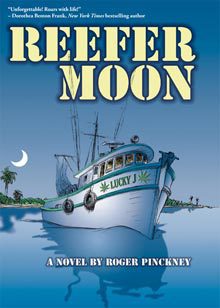
It took many years, but I finally accepted Roger’s invitation a few weeks ago and visited him on one of the last undeveloped Sea Islands on the South Carolina coast, just southwest of Hilton Head on Calibogue Sound, the beautiful and spiritual Daufuskie Island.
It seems a bit oxymoronic to even mention Facebook in this profile dedicated to an author and cultural icon inspired by all things opposite of technical and modern. But Facebook is exactly how we reconnected. Bonita Wreden, a longtime friend and famed local musician, messaged me one evening and said, “Wendy I’m hosting a book club in September, and we’re reviewing Reefer Moon by Roger Pinckney. Would you like to write a story?”
As quickly as she hit send to me, I was writing Roger to take him up on his 7-year-old offer to visit him on Daufuskie. If I was going to help review the book, I wanted to experience Pinckney’s true life on Daufuskie; and, thankfully, the offer still stood, which I found out via Facebook instant message.
Though casually direct in appearance and speech, Roger is the epitome of a southern gentleman. He followed up his Facebook summons with a phone call and offered my daughters and me a behind-the-scenes tour of Daufuskie. We kindly accepted, and our journey to understand Roger’s passion for the island only approachable by boat began.
Roger coordinated the ferry ride for us. Bonita accompanied Abbie (9), Julia (7) and me on The 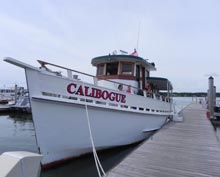 Calibogue, captained by Scott Hammet and owned by Wick Scurry who operates Calibogue Cruises.
Calibogue, captained by Scott Hammet and owned by Wick Scurry who operates Calibogue Cruises.
As we departed the dock at Broad Creek Marina, we marveled at the Bottlenose Dolphins playfully jumping along the port side of the beautifully restored 1919 motor ferry. Bonita and I recognized Delbert Felix on the boat ride, a bass player with Whitley Deputy and the B-Town Project. We spoke to the rest of the band, Whitley Deputy, James Smith and Will Snyder on the way to Freeport Marina, where they would play for day-trippers relaxing waterside until the ferry came again at dusk.
When we arrived at Freeport, Roger was waiting for us, patiently perched on a picnic table with his signature pipe in mouth.
“Hey, Darlin’. Ya’ll must be hungry. Get yourself something to eat,” as he hugged Bonita and me and introduced himself to Abbie and Julia, who immediately took comfort in his calm approach.
Abbie and Julia spent about 30 seconds devouring cheeseburgers made dockside by Old Daufuskie Crab Company, managed by Don Stanchak. One day I will write an entire additional article about the food there! I had the Chili Thai skewered shrimp, and I think they were, without a doubt, the best shrimp I’ve ever had anywhere in the Lowcountry, and I’ve lived here my entire life. Point made?
Roger then made some personal introductions of islanders who make Daufuskie home, and I was humbled and honored that they made time to see me. Future visits to the island will definitely include more time with these entertaining men, each with a unique story of his own but all equally engaged with the physical environment and multi-dimensional spirituality that defines Daufuskie.
I met Patrick Ford, the Golf Pro and hero who saved Melrose Golf Course from financial ruin and is now trying to d o the same thing at Bloody Point; Wendell Matthews, musician who composed the CD, Beneath the Reefer Moon to accompany Pinckney’s book; and Wick Scurry, entrepreneur who owns and operates Freeport Marina while maintaining close relationships with natives of the island and even gives tours himself.
o the same thing at Bloody Point; Wendell Matthews, musician who composed the CD, Beneath the Reefer Moon to accompany Pinckney’s book; and Wick Scurry, entrepreneur who owns and operates Freeport Marina while maintaining close relationships with natives of the island and even gives tours himself.
For each of these men, and Roger too, Daufuskie brings intrinsic peacefulness and enables them to continue their professions while preserving the island’s culture.
Roger describes most of the 300 permanent residents of the island as “fiercely independent,” a narrative that explains why 64 of those residents are artisans. That’s right. Almost a quarter of the residents are woodworkers, painters, potters, jewelry designers and more. And most sell right out of their houses on the island.
And Roger is obviously included in this category of folk. After graduating from the University of South Carolina, Roger earned an MFA through the Iowa Writers Workshop. He wrote award-winning features for both Minnesota and North Dakota newspapers. His first successful book was Blue Roots, a history of voodoo in South Carolina. In addition to Blue Roots, he’s written several collections of essays, beginning with Right Side of the River. And, a Hollywood independent filmmaker has purchased his novel, Little Glory.
Roger is also a two-time winner of the South Carolina Fiction Project and Orion Writing Circle Award. He’s devoted to his craft, and he’s emerging as the Lowcountry literary expert on hunting, fishing… and voodoo. And he’s catching the attention of southern writers everywhere for his straightforward, masculine descriptions of natural beauty, property ethics and cultural preservation. For example, this is what John Lane, author of Chattooga and Circling Home, had to say about Roger Pinckney: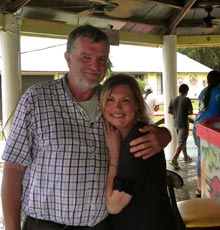
“Coastal activist, novelist and give ‘em hell writer of environmental essays, Roger Pinckney is our Tom Paine of the tides, and this time he’s really done it – Midnight in the Garden of Kiss My Ass.”
Roger gave Bonita, Abbie, Julia and me a private tour around Daufuskie in his personal vehicle. The girls were innocently delighted when they were told, “Seatbelts are not required.”
Our travels around the island included visits to cemeteries, churches, schools, art galleries, farms, plantations, historic landmarks and multiple testimonies of the African magic belief system…voodoo.
We learned about the Webb tract and the controversial development plan from Halliburton, the violence and threats that arose from it and the voodoo that was prelude to the ultimate demise of the contract.
And that was the beginning of the discussion of voodoo and African rituals. Abbie and Julia were curious now. They began to understand haunts and hags, the significance of Haint Blue and why some graves faced the native land and others faced the opposite direction.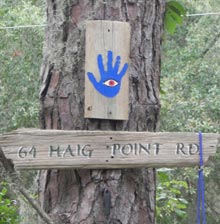
Without going into too much detail about specific acts of voodoo, Roger explained to my young daughters that the Gullah heritage strongly believes in another dimension, one that includes their ancestors who distinctly know the difference between good and evil.
We also understood burial societies, the separation between males and females during worship services and final acts of community approvals or disapprovals of a person when they die.
We visited Chase Allen’s art studio and gallery, called Iron Fish, where it’s acceptable to choose your art and slip payment under the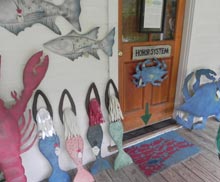 door when Chase is unavailable. We were able to take some Palmetto Honey and leave a few bucks, because we missed meeting Chase. His art is amazing, and there is a mermaid on the porch with my name on it. Just a subtle hint if anyone is interested.
door when Chase is unavailable. We were able to take some Palmetto Honey and leave a few bucks, because we missed meeting Chase. His art is amazing, and there is a mermaid on the porch with my name on it. Just a subtle hint if anyone is interested.
Abbie and Julia were also very interested in a plant we found on the island, one that Roger knows a great deal about. Why? Because, he’s a descendant of a pretty famous woman who developed this plant into one of South Carolina’s most important cash crops. That’s right, it’s indigo, and Eliza Lucas Pinckney realized that the growing textile industry was creating world markets for new dyes; so starting in 1739, she began cultivating and creating improved strains of the indigo plant from which a blue dye can be obtained.
There is so much history on the island, and Roger knows it backwards and forwards. I could go on and on in this article about what we learned, but there’s no comparison to an actual tour that the public is welcome to attend. Just visit www.daufuskiefreeport.com and sign up for a guided bus tour or rent a golf cart and explore yourself.
We were fortunate to take another tour while on the island with another Daufuskie preservationist, Wick Scurry. Wick’s tales of life on the island or so extensive, I’ll have to save his story for another issue. But I will describe a meeting that Wick arranged between me, the girls and Flossie Washington, an 87 year-old woman who was born and raised on Daufuskie.
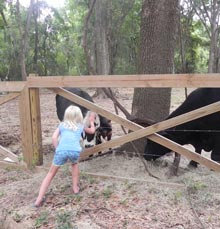
Flossie has fifteen children and no idea as to how many grandchildren she has. She was married to Jake Washington, Wick’s best friend before he passed a few years ago. Flossie is notorious for her deviled crab and cooking that only includes gathered produce that’s farmed on the island, meat from animals that graze the island or seafood that swims around the island.
Flossie loves her life on Daufuskie… always has. She’s been quoted as saying, “I didn’t know I was poor until I read it in the paper.” And that written quote lacks Gullah dialect that would probably sound more like this: “Didn’t no I’s po’ til I read it da pappa.”
Flossie was an angel. Her wisdom resonated with my girls. They had an immediate respect for Flossie, as did she for my dau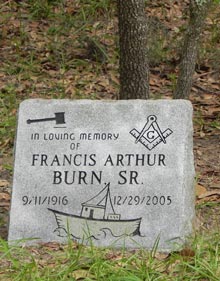 ghters. Their minds were not segregated, not in the least. Flossie’s societal innocence and Abbie and Julia’s youthful blindness to race created a peaceful interaction void of economic, age, cultural or racial prejudice. I was moved; but Wick knew that’s exactly what would happen if he brought us to her house. And I’m so glad he did. I will always remember our visit with Flossie.
ghters. Their minds were not segregated, not in the least. Flossie’s societal innocence and Abbie and Julia’s youthful blindness to race created a peaceful interaction void of economic, age, cultural or racial prejudice. I was moved; but Wick knew that’s exactly what would happen if he brought us to her house. And I’m so glad he did. I will always remember our visit with Flossie.
Our meeting with Flossie was close to the end of our day on Daufuskie. After our tour, we picked up Roger’s wife Amy and headed back to Freeport Marina, where we listened to music, played corn hole and listened to the locals tell about their adventures and life on Daufuskie. It’s certainly a different way of living, but one that I wanted to understand so I could read Roger’s new book, Reefer Moon, with a better idea of the real Roger Pinckney…what makes him tick, what boils his blood, what is it that he prays for and why he a vigilant supporter of Daufuskie preservation.
Now I will read Reefer Moon, just in time for Bonita’s book club meeting in September, and know just what Roger is writing about. Dorothea Benton Frank says:
“Nobody knows the South Carolina Lowcountry like Roger Pinckney, hunter, fisher and voodoo man. He’s the real thing. When Pinckney writes about love on a moonlit beach, you know he’s been there. Facing down a wild boar in a briar patch, you know he’s been there too. Reefer Moon is a cry for wild places, on the Earth and in your heart. Unforgettable! Roars with Life!”
So my suggestion now? Go to Daufuskie! There’s plenty of time this summer to take your boat or catch a ferry from Calibogue Cruises. And look out for a piece by our very own Backyard Tourist, Mark Shaffer, for an in depth look at Daufuskie, its landmarks and more of its history.
After you visit Daufuskie and maybe even meet Roger Pinckney, get your copy of Reefer Moon at the General Store on the island or at any bookstore in Beaufort, Bluffton and Hilton Head.
Between now and September, we will all read Reefer Moon and talk about it on  the Lowcountry’s first virtual book club. Look for Lowcountry Book Club on Facebook and like the page. Our first book to review is Reefer Moon. My second piece on Roger Pinckney, after Bonita’s book club meeting, will focus on the book and the Lowcountry’s review.
the Lowcountry’s first virtual book club. Look for Lowcountry Book Club on Facebook and like the page. Our first book to review is Reefer Moon. My second piece on Roger Pinckney, after Bonita’s book club meeting, will focus on the book and the Lowcountry’s review.
Again, I suggest before you read the book, travel to Daufuskie! Get your copy of Wendell Matthews’ CD while you’re there as well. We’ve got a long summer ahead of us. Why not get in the hammock under a live oak, listen to some original tunes like “The Ballad of Alice Flagg” and “Mean Ole Gator” and open your minds to literary magic? Reefer Moon seems like the perfect summer read, and I’m looking forward to sharing the experience with you.
Thank you Roger Pinckney for a delightful visit, an educational tour and, most importantly, an experience my daughters and I will remember for a lifetime.
Until September…


